Hydrangea tree. Hydrangea paniculata - varieties, planting, care
It does not require complex care, it winters well without shelter and has a very long flowering period. By now, breeders have bred many varieties - so you can spend a couple of decades just collecting it and not get bored. It is also honey-bearing.
Spread
In the wild, the tree hydrangea is common in Japan and China, as well as in the south of Sakhalin. As an ornamental plant, it is grown absolutely everywhere - from North America to Australia.
Description
Panicle hydrangea is a shrub or a short tree. However, sometimes it is high - up to 10 meters - but most often 3 ... 4.
Stems are erect, woody. The plant is densely leafy. Leaves are cordate and ovate with a pointed apex and a serrated edge, sitting on long petioles. Thanks to the succulent foliage, the plant looks quite decorative even without flowers.
There are two types of hydrangea flowers:
- sterile (sterile) - serve to attract pollinators. Flower size up to 3 cm. Corolla consists of 4 petals. At the beginning of flowering, they are white, and then they acquire a creamy color. They are located along the edge of the inflorescence;
- Fertile (fertile) - form fruits and seeds. These flowers are small, with petals falling early. Isolate nectar, which bees willingly collect.
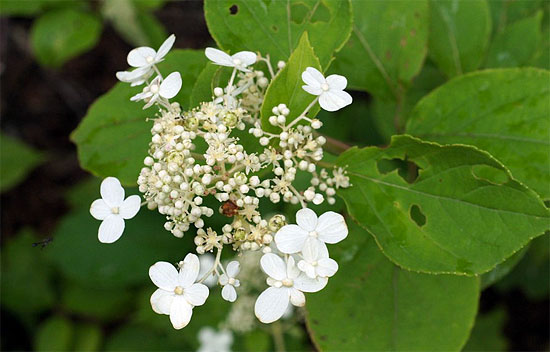
Flowers are collected in large paniculate inflorescences. In some varieties, the panicle length reaches 35 ... 40 cm. Inflorescences appear in the second half of June, but flowers bloom very slowly. The peak flowering of hydrangea paniculata is in August and September.
Interestingly, during the entire flowering period, the color of the inflorescences changes, at first they are greenish, immediately after blooming, white or cream, and by autumn they acquire a consistent pink, brick, light purple and finally greenish tint again.
The fruit is a small, multi-seeded capsule. Since hydrangea blooms for 4 years, its seeds are rarely harvested, even if they ripen. Plants are usually propagated by cuttings.

Varieties
To date, breeders from different countries have created more than 100 varieties, which differ from each other in the size of the inflorescence, the color of the petals and sometimes the shape of the plant itself. Their photos and descriptions are given in the article "Varieties of hydrangea paniculata". Only the most popular ones will be briefly discussed here.
"Grandiflora"
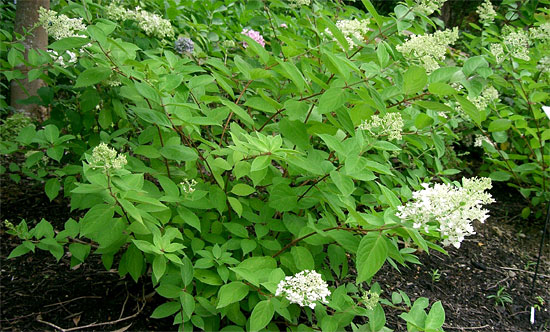
Some authors consider panicle hydrangea "Grandiflora" not as a variety, but as a garden form in general. In catalogs it may be referred to as "PG" (Paniculata Grandiflora) and be regarded as synonymous with the cultivated hydrangea in general.
Hydrangea "Grandiflora" can reach a height of 4 meters. It is characterized by large, heavy inflorescences with a large number of sterile flowers - also quite large. Freshly blooming flowers are white, then cream.
This form is extremely winter-hardy: it can withstand frosts down to -40 ° C without any shelter.
"Vanilla Fraise"

Number 1 in popularity. Plants usually grow to a height of about 2 meters and a width of up to 1.5 meters. Inflorescences are large, broadly pyramidal with a large number of sterile flowers. At first, the flowers are white, but quickly turn pink, and pink can be a very rich shade. Long flowering, winter-hardy variety.
"Phantom"

Sprawling bushes, up to 2 meters high. The Phantom hydrangea is characterized by very large conical inflorescences. When blooming, the flowers are creamy, over time they acquire a slightly pinkish tint. Winter-hardy variety.
Hydrangea paniculata - features of cultivation
Panicle hydrangea is a rather unpretentious and easy-to-grow shrub that forgives the gardener many mistakes. It blooms on the shoots of the current year, which have time to fully mature before the onset of cold weather. Hydrangea is very hardy and can be grown without winter shelter even in the Leningrad Region and Karelia.
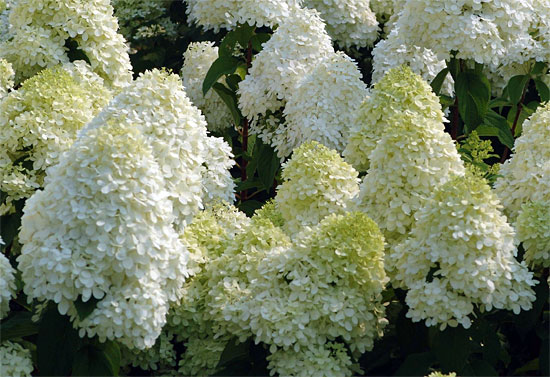
The plant begins to bloom profusely from 4 years of age and blooms up to 40 years. Hydrangeas tolerate pruning well and form easily. They practically do not have dangerous diseases and pests. It is an ideal plant for a small maintenance garden - once planted, they can only be watered.
Planting and leaving
Choosing a landing site
Hydrangea paniculata prefers loose, moderately fertile, slightly acidic and acidic soils. The optimum pH of the soil solution is 4.5 ... 5.5. The soils must be well-drained: plants do not tolerate flooding of the root system very well and may die. At the same time, groundwater at a depth of about 1 meter is not dangerous for them, because most of the roots are located higher.
Plants are light-requiring enough, but ideally should be protected from the midday sun. If you can place the hydrangea so that a light shadow falls on it in the summer afternoon, and the rest of the time it is lit, it will be very good.
The site must be protected from the wind.
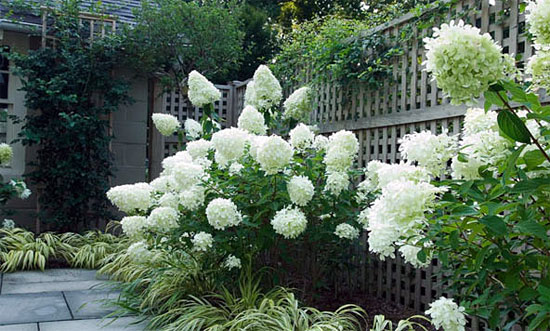
Landing
The best time to plant panicle hydrangea is spring, but container plants can be gently transferred with a lump of earth at any time. Winners in open ground plants are allowed to be planted immediately after the ground has thawed, plants from greenhouses - after frosts have passed.
Planting pit preparation
The size of the planting pit depends on the size of the seedling, but in any case it should be at least 50 x 50 x 50 cm. If the soil is light and underlain by sand or sandy loam, a layer of clay 10-15 cm thick is placed on the bottom of the hole. If the soil is heavy, on at the bottom of the pit, it is necessary to make a drainage layer of expanded clay or crushed stone.
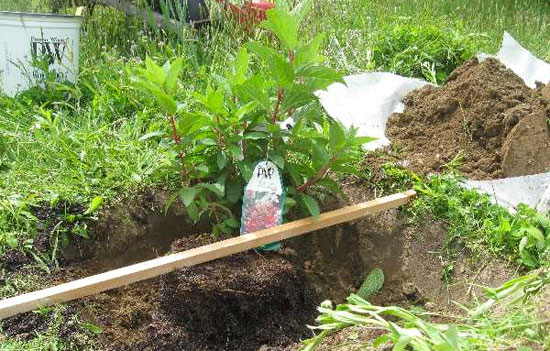
The pit is filled with a soil mixture, which consists of peat, sand and humus in a ratio of approximately 2: 1: 2. In addition, about 50 grams of simple superphosphate and 50 grams of potassium sulfate are added to the mixture for each pit.
If the plant has a pronounced main stem, it is placed so that the root collar is located 3 ... 4 cm above the ground level: in this case, after watering and tamping the soil, it will be just at the zero level. If there are several trunks, the root collar is placed at the zero mark, and then after watering it will deepen a little.
The hydrangea is planted in the same way as any other trees and shrubs. A mound is poured at the bottom of the pit, then the roots are spread along its slope and fall asleep, ramming the earth and periodically shaking the plant slightly so that the soil mixture fills all the voids. If the plant comes with a lump of earth, it is carefully rolled over to keep the lump. Seedlings in containers are more expensive, but take root much better. However, panicle hydrangea generally takes root well.
After planting, the hydrangea is watered abundantly, the soil mixture is poured and tamped again.
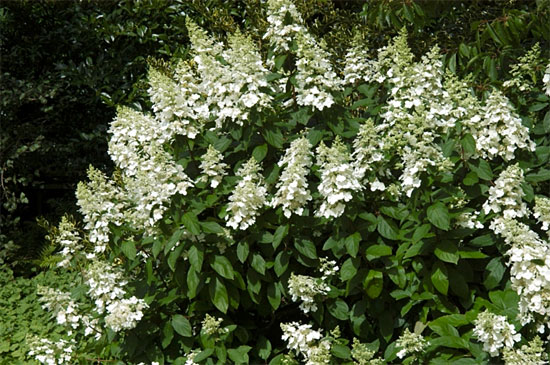
Kyushu variety
Care
Caring for paniculate hydrangea is simple and comes down almost exclusively to watering and pruning.
Spring
- Remove last year's leaves and weeds from the trunk circle.
- If the trunk circle was not mulched in the fall, carefully loosen the soil to a shallow depth, apply mineral fertilizers at the rate of about 10 grams of nitrogen, phosphorus and potassium per 1 m2 of the trunk circle.
- Prune the plant.
Pruning hydrangea paniculata
Panicle hydrangea forms shoots from all buds on last year's shoots and many buds on older wood. Almost all shoots of the current year give inflorescences, the formation of which the plant spends a lot of resources. If no pruning is done, the plant weakens quickly and the inflorescences become smaller.
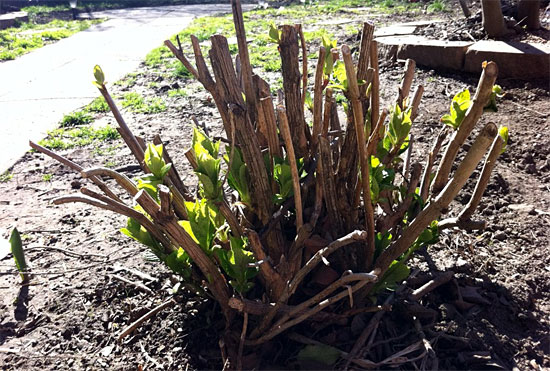
Formative pruning of young plants
Plants with a pronounced stem are formed in the form of a tree. In the early years of such a plant:
- remove all zero (growing from the ground) shoots, except for the main stem;
- the main stem is tied up vertically;
- the tops of annual shoots are pinched in the summer and left until next year;
- shoots of the last year are cut "on the ring".
This pruning is carried out until the plant reaches a height of about a meter. After that, a crown is formed from the shoots of the current year, pinching them in the summer, but not cutting off the next year.
From the age of 4, the plant is pruned to form a crown of the desired shape.
Sanitary pruning
The panicle hydrangea practically does not freeze, and therefore its spring sanitary pruning is reduced to the removal of broken shoots.
Thinning and flowering pruning
- Remove all shoots directed towards the inside of the crown.
- Cut off weak shoots that are competitors of the strong.
- shorten the shoots of the last year, leaving 1 ... 3 pairs of buds on it. The thicker the shoot, the more buds you can leave on it. These buds will give rise to shoots of the current year with inflorescences: if there are many of them, the inflorescences will turn out to be small.
Anti-aging pruning
Cut off large old branches with damping growth. They can be cut at the trunk itself "on the ring" or after the first branch of the second order.
Bush formation
As I noted above, the hydrangeas formed by the bush are slightly deepened when planting so that they give new zero shoots. In the spring, weak zero shoots are removed, and strong ones are cut off, leaving 1, 2 or 3 pairs of buds. In addition, weak, damaged or inward-directed shoots of the first and second orders are removed.
Summer care

It's very simple:
- Weed control;
- Abundant watering in dry weather;
- Top dressing with full complex fertilizer in the budding phase. The application rate is the same as in the spring, a little less is possible.
- Garter of leaning shoots with large, heavy inflorescences. This is especially important if the summer is rainy. Hydrangea inflorescences are able to accumulate a large number of water and become very heavy.
Care for hydrangea paniculata in autumn, preparation for winter
In the fall, the inflorescences are cut off from the hydrangea and the damaged shoots are removed. After pruning, the plants are slightly spud and the trunk circle is mulched. High moor peat or coniferous bark can be used as mulch.
It is not necessary to cover the panicle hydrangea - it does not freeze even in the most severe frosts - but snowfalls can be dangerous. Hydrangea wood is very fragile: snow falling from the roof and just a large layer of snow lying on the branches can break them. Therefore, it is better to carefully tie large branches together, and if necessary, also tie them to a support. After the snow melts, they are freed.
Hydrangea is a real decoration of our garden. It is a very beautiful and long flowering plant. But, it can become even more decorative if you pay a little attention to the formation of a bush or tree.
The most common varieties of hydrangea are treelike and paniculate. They are unpretentious and frost-resistant.

Paniculata hydrangea reaches, on average, 2 meters in height. Blooms in June-August, inflorescences resemble lilac inflorescences. At the beginning of flowering, it is white, and closer to autumn it acquires a pink-crimson hue. Some varieties of hydrangeas smell.
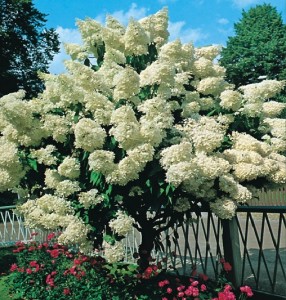
If you want a beautiful Hydrangea bush, then it is advisable to bury the seedling a little into the soil. Then from the buds that end up in the ground, shoots will go, forming a lush bush. Weak shoots must be removed. The crown is formed next year by cutting off the branches to 2-3 pairs of buds. The weak are removed again.
In the form of a bush, large-leaved, paniculate and tree-like hydrangeas are formed.
But the most interesting thing is that you can grow a real tree from a hydrangea. And with your own hands. Such a tree is called - standard. It is very interesting to see him in the garden; it is very unusual and beautiful. So how do you grow it ...

It is better to grow Hydrangea paniculata and tree-like on the trunk.
We select a seedling and plant it separately; it is not necessary to deepen the seedling.
For 3-4 years, we regularly pay increased attention to it. - we are engaged in pinching and pruning of the selected hydrangea for the upbringing of the "trunk".
The selected seedling has a main shoot from the base, which will be the stem. We pinch the rest of the shoots in the summer 1-2 times. This contributes to an increase in the diameter of the hydrangea stem, therefore such branches are called thickening shoots. And when they fulfill their role, they are then cut into the ring in June. Annually, at the beginning of a new growth of hydrangea, the "leader" shoot is shortened to a well-developed bud.
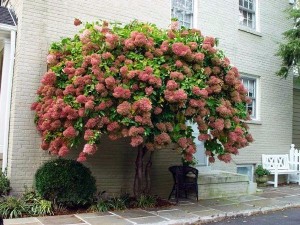
At a height of 1-1.5 meters, a crown of a standard hydrangea is laid. For this, the stem is cut off, and skeletal branches develop from several buds located below the cut (4-5).
The next year, the crown of the hydrangea stem is formed. To do this, leave 2-4 pairs of eyes on all the annual shoots obtained. This operation is repeated for the next 1-2 years, until a "tree" with a strong stem and a beautiful crown is obtained from the selected hydrangea seedling.
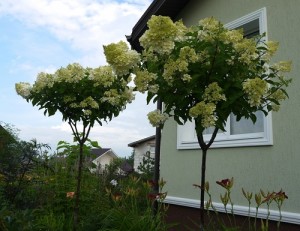
After planting the resulting standard tree in a permanent place, you should still pay attention to it regularly. You need to monitor the crown and pay attention to the trunk, give all unnecessary shoots and cut out the growth from the base of the plant.
The splendor of flowering, the size of the inflorescences, whether it will be ornamental plant generally bloom and how it will fit into your landscape.
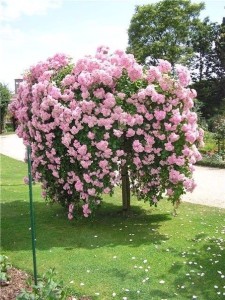
Hydrangeas formed by a standard tree are very winter-hardy. But in severe winters, especially young plants in the first years after planting, it is advisable to cover them with dry leaves or spruce branches. To protect against frost damage, the trunks of standard specimens are wrapped in sacking in several layers. With age, the winter hardiness of hydrangeas increases, and then the shelter can be abandoned.
Stamp form Hydrangeas are used by landscape designers to create "Japanese gardens" and mixed mixborders of almost any style. These plants look good both in tapeworms and in groups on lawns, gazebos, verandas or porches. If you have a long fence, then plant a panicle hydrangea along with lianas (petiolate hydrangeas, maiden grapes, princes, curly honeysuckle) along it. Hydrangea in standard form can also be grown in tubs on the balcony.
Hydrangea is a real decoration of our garden. The most common varieties of hydrangea are treelike and paniculate. They are unpretentious and frost-resistant. The tree hydrangea has proven to be the best example. With minimal care, it winters well without shelter and annually pleases us with its beautiful flowers, its inflorescences reach 30 cm in diameter. Paniculata hydrangea reaches, on average, 2 meters in height. Blooms in June-August, inflorescences resemble lilac inflorescences. At the beginning of flowering, it is white, and closer to autumn it acquires a pink-crimson hue. Some varieties of hydrangeas smell. But the most interesting thing is that you can grow a real tree from a hydrangea. And with your own hands. Such a tree is called - standard. It is very interesting to see him in the garden; it is very unusual and beautiful. So how do you grow it ...
We select a seedling and plant it separately. For 3-4 years, we regularly pay increased attention to it. - we are engaged in pinching and pruning of the selected hydrangea for the upbringing of the "trunk".
1.
2.
3.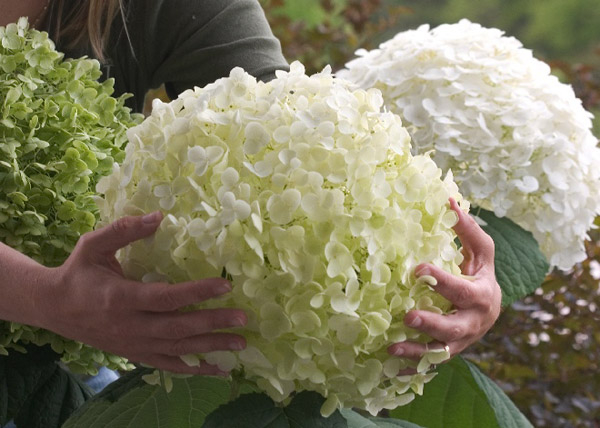
The selected seedling has a main shoot from the base, which will be the stem. We pinch the rest of the shoots in the summer 1-2 times. This contributes to an increase in the diameter of the hydrangea stem, therefore such branches are called thickening shoots. And when they fulfill their role, they are then cut into a ring. Every year, at the beginning of a new growth of hydrangea, the "leader" shoot is shortened to a well-developed bud. 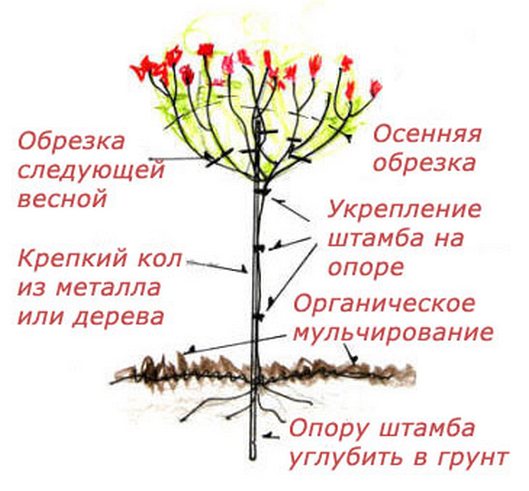
At a height of 1-1.5 meters, the crown of a standard hydrangea is laid. For this, the stem is cut off, and skeletal branches develop from several buds located below the cut (4-5). 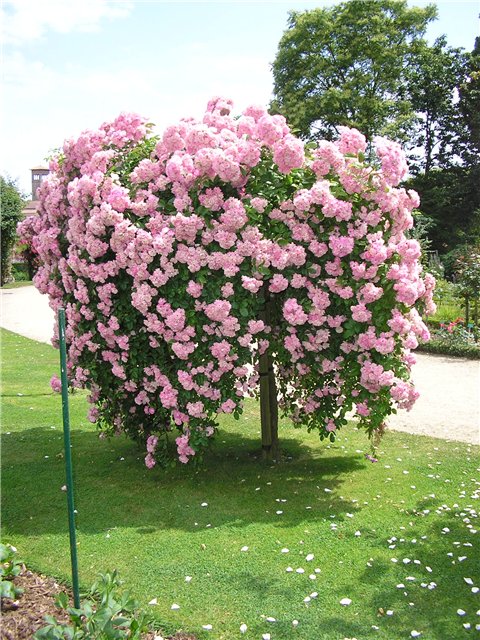
The next year, the crown of the hydrangea stem is formed. To do this, leave 2-4 pairs of eyes on all the annual shoots obtained. This operation is repeated for the next 1-2 years, until a "tree" with a strong stem and a beautiful crown is obtained from the selected hydrangea seedling. 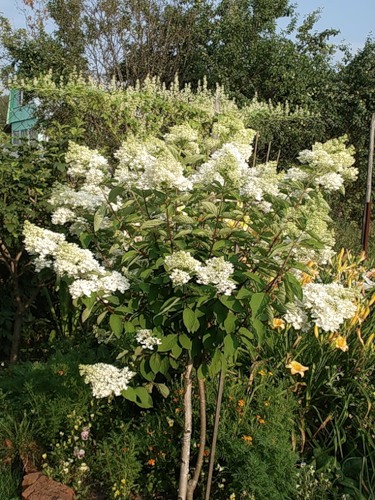
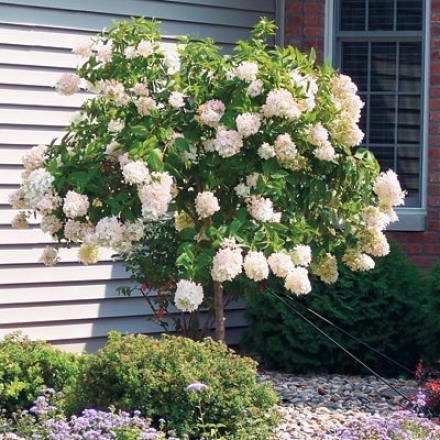
After planting the resulting standard tree in a permanent place, you should still pay attention to it regularly. You need to monitor the crown and pay attention to the trunk, give all unnecessary shoots and cut out the growth from the base of the plant.
1.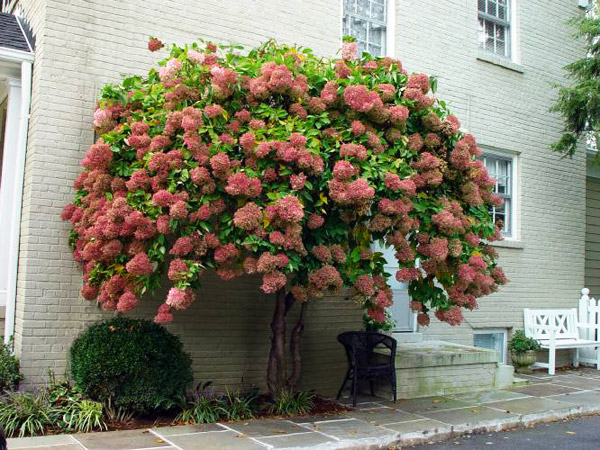
2.
3.



